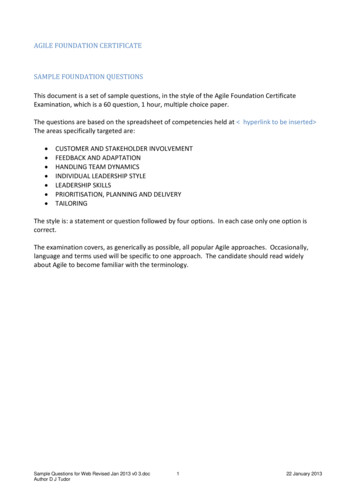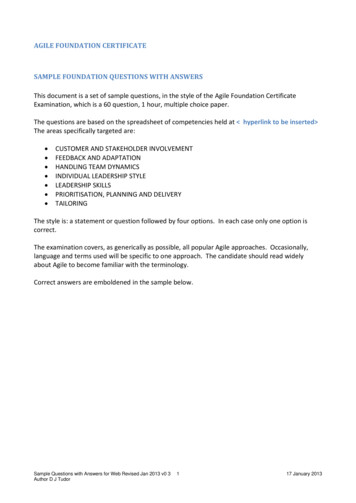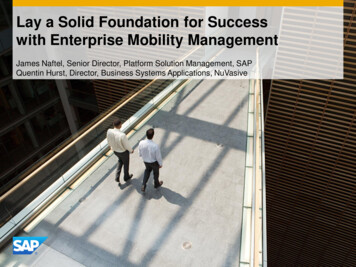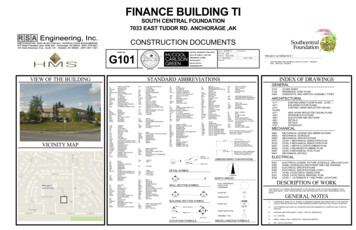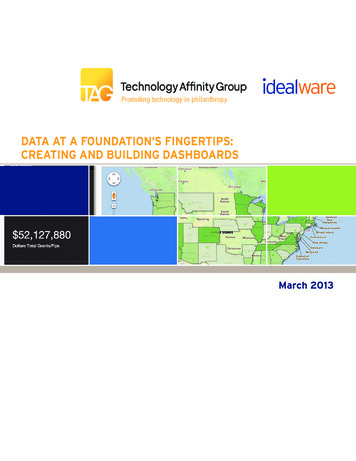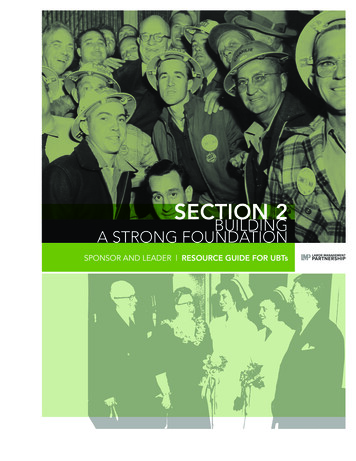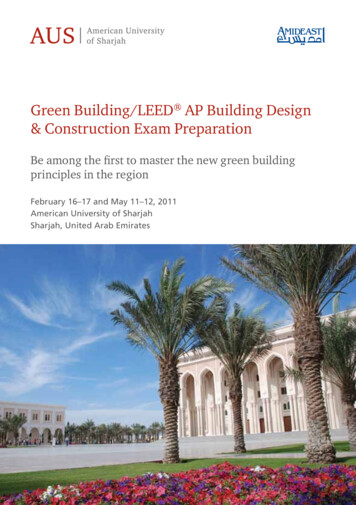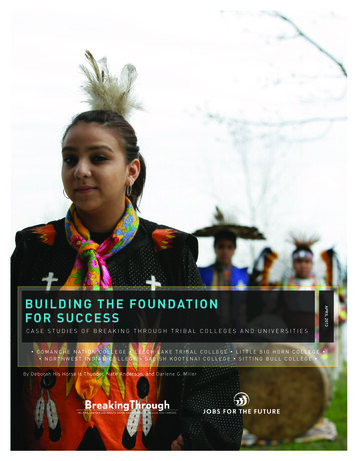
Transcription
APRIL 2013BUI LD I N G TH E FOUNDATI ONFOR S UC CESSCASE STUDIES OF BREAKING THROUGH TRIBAL COLLEGES AND UNIVERSITIES C O M A N C H E N AT I O N C O L L E G E L E E C H L A K E T R I B A L C O L L E G E L I T T L E B I G H O R N C O L L E G E NORTHWEST INDIAN COLLEGE SALISH KOOTENAI COLLEGE SITTING BULL COLLEGE By Deborah His Horse Is Thunder, Nate Anderson, and Darlene G. Miller
CAI H EAMERICAN INDIANHIGHER EDUCATION CONSORTIUMThe American Indian Higher Educationthrough 2015. Walmart has donated more than onebillion meals to those in need across the country.WALMART.COMConsortium was established to serve a uniquecommunity of tribally and federally charteredcolleges working to strengthen tribal nations andmake a lasting difference in the lives of AmericanIndians and Alaska Natives. Tribal Colleges andThe National Council for Workforce Education isUniversities were created in response to the highercommitted to promoting excellence and growth ineducation needs of American Indians and generallyworkforce education. As an affiliate council of theserve geographically isolated populations that haveAmerican Association of Community Colleges, NCWEno other means accessing education beyond theprovides a national forum for administrators andhigh school level. Tribal Colleges and Universitiesfaculty in workforce education and basic skills, ashave become increasingly important to educationalwell as representatives of business, labor, military,opportunity for American Indian students and areand government, to affect and direct the future roleunique institutions that combine personal attentionof two-year and other postsecondary institutionswith cultural relevance to encourage Americanin workforce education and economic development.Indians—especially those living on reservations—toNCWE provides the link between policy andovercome the barriers they face to higher education.workforce education and economic development byAIHEC joined in this partnership to introduce theproviding support, research, and critical informationBreaking Through strategies to six tribal colleges.to members on current and future trends andWWW.AIHEC.ORGpolicies.WWW.NCWE.ORGJobs for the Future works with our partners todesign and drive the adoption of education andcareer pathways leading from college readiness tocareer advancement for those struggling to succeedin today’s economy.WWW.JFF.ORGBreaking Through promotes and strengthensthe efforts of more than 50 community collegesin 22 states to help low-skilled adults preparefor and succeed in occupational and technicaldegree programs. Counteracting high attritionrates in Adult Basic Education and developmentaleducation programs, Breaking Through collegesimprove outcomes by focusing on strategies thatcreate effective pathways through pre-collegeWalmart and the Walmart Foundation areand degree-level programs and result in collegecommitted to helping people live better throughcompletion. The initiative is proving that low-philanthropic efforts. By operating globally andskilled adults can advance through remediation andgiving back locally, Walmart is uniquely positionedcredential programs within a reasonable time andto address the needs of the communities it serveswith reasonable success. Most recently, Breakingand make a significant social impact within itsThrough, collaborating with the American Indiancore areas of giving: Hunger Relief and Nutrition,Higher Education Consortium, established programsSustainability, Career Opportunity and Women’sat six tribal colleges. Breaking Through providesEconomic Empowerment. Walmart and the Walmarttechnical assistance to each campus, integratesFoundation are leading the fight against hungerthe new colleges into the national network, andin the United States with a 2 billion commitmentestablishes a peer-learning network among them.BREAKINGTHROUGHCC.ORG
A BO U T THE A U T HOR SNate Anderson works on the AcceleratingOpportunity and Breaking Through initiativesDeborah His Horse Is Thunder has worked withat Jobs for the Future as a technical assistanceTribal Colleges and Universities as a chief academicprovider and policy coach to community colleges,officer, faculty member, and consultant for nearly 20tribal colleges, and state agencies across theyears. She is a Nakoda who makes her home on thecountry. In addition, Anderson manages JFF’sStanding Rock Indian Reservation in North Dakota.Adult Completion Policy project, which focusesShe currently works with the American Indianon implementing prior learning assessmentsHigher Education Consortium on Tribal Collegesstatewide, and he serves as a state coach for a U.S.Breaking Through as well as the Walmart StudentDepartment of Education initiative seeking to alignSuccess Collaborative. Previously, Dr. His Horse Iscareer and technical education with adult careerThunder served as the membership director and thepathway programs. He also manages a Michiganproject director for the TCU Leadership Project forinitiative to bridge noncredit and credit programs atAIHEC, and she has held positions at Haskell Indiansix community colleges. Previously at JFF, AndersonNations University, Fort Peck Community College,worked on Lumina Foundation for Education’sand Fort Belknap College. Dr. His Horse Is ThunderProductivity Agenda, an initiative to improveholds a doctorate in guidance and counselingcompletion rates at two-year and four-year publicfrom the University of Montana and a Master’scolleges within the constraints of existing resources.in Education, with a focus on adult and higherHe holds a Master’s from the Harvard Graduateeducation, from Montana State University. She has aSchool of Education.Bachelor’s degree in sociology.Darlene G. Miller has served as executive directorof the National Council for Workforce EducationACKNOWL EDGEMENTSsince 2010. Dr. Miller has over 20 years experienceBuilding the Foundation for Success owes specialworking in community colleges with expertisethanks to the six colleges covered in this report,in workforce and economic development. Priorand in particular to each of the project leads forto joining NCWE, she served as president oftheir support, guidance, and collaboration: ConsueloManchester Community College in New HampshireLopez at Comanche Nation College; Roberta Spottedand vice president of workforce and economicHorse, David Yarlott, and Jemima Cameron at Littledevelopment at Shoreline Community College inBig Horn College; Karen Cary at Leech Lake TribalShoreline, Washington. Dr. Miller started in higherCollege; Fran Dodson at Northwest Indian College;education as a faculty member at Vermont TechnicalStacey Sherwin and Steve McCoy at Salish KootenaiCollege, teaching mathematics, computer science,College; and Koreen Ressler at Sitting Bull College.and engineering. Dr. Miller has a Master’s inbiomedical engineering from Rensselaer PolytechnicInstitute and a doctorate in higher education, policy,research and administration from the University ofThe Walmart Foundation generously provided thefunding for Tribal Colleges Breaking Through andthis report.Massachusetts, Amherst.PHOTOGRAPHY COVER 2008 Jerry DavisPHOTOGRAPHY INSIDE courtesy of Comanche Nation College, Leech Lake Tribal College, Little Big Horn College, Northwest Indian College, SalishKootenai College, Sitting Bull College
TA B LE OF CON TENTSExecutive SummaryviiIntroduction1Breaking Through Strategies1Tribal Colleges and Universities2Tribal Colleges and Universities Breaking Through2The Case Studies4Comanche Nation College5Leech Lake Tribal College9Little Big Horn College13Northwest Indian College17Salish Kootenai College22Sitting Bull College26Moving Forward30Building Relationships to Support Success32
E XE CU T I VE S UMMA R YTribal Colleges Breaking Through, a partnershipto identify a wealth of strategies, resources, andof Jobs for the Future, the National Council forexpertise to enhance their Breaking ThroughWorkforce Education, and the American Indianprojects. The end result was a much strongerHigher Education Consortium, was an eighteen-approach than might ever have been developed bymonth initiative focused on piloting workforce anda single institution. Even now, many of the TCBTeducation strategies to better serve low-skilledstaff continue to work directly with one another as astudents at tribal colleges and universities. Sixresult of this process.institutions participated—Comanche Nation College,Leech Lake Tribal College, Little Big Horn College,Northwest Indian College, Salish Kootenai College,and Sitting Bull College—with each establishingtwo or more cohorts of GED or workforce studentsand incorporating the four Breaking Through corestrategies. The colleges also joined the nationalBreaking Through network of colleges and attendedsemiannual peer learning meetings designedto further promote effective approaches foracademically underprepared students.Alignment with Employer Demand: The emphasison workforce programs designed around employerdemand, while not new to many of the colleges, wasnevertheless a greater focus of TCBT than it was inmost previous initiatives. A great deal of learningtook place as a result. Colleges experimentedwith a number of related strategies, includingcontextualization, employability skill development,the use of labor market data, and stackablecertificates. The result was a deeper appreciationfor linking local labor markets to college programs,Data from the participating colleges suggestwith the goal of improving student retention,that Tribal Colleges Breaking Through has hadcompletion, and job placement rates.a significant impact. TCBT institutions pilotedBreaking Through with roughly 400 studentsand awarded more than 450 industry-recognizedcredentials and GEDs during the 18-month initiative.Most of the colleges reported improved studentoutcomes (e.g., college readiness, transitions tocollege, retention rates, credential attainment rates,and job placement) relative to their traditional,non-Breaking Through programs. Surveys and otherqualitative data collection efforts tended to supportimproved student, faculty, and staff satisfactionas well.As a result of experimenting with theimplementation of Breaking Through in a tribalcollege context, a number of key themes emergedduring the initiative:Senior Leadership Engagement: In most BreakingThrough colleges, the initiative is isolated in adulteducation or workforce departments that areremoved from the regular college classes. In TCBT,there was a strong level of senior-level engagement.Presidents and chief academic officers attendednational meetings, led the TCBT project personally,and interacted directly with students in theircohorts. This level of engagement allowed for ahigher degree of institutionalization of the initiative,enabling the colleges to make the Breaking Throughcore strategies the norm and increasing thevisibility on campus of low-skilled adult learners.Culturally Contextualized Instruction: A usefulstrategy employed by many TCBT participants,and one that is specific to tribal colleges, was thePeer Learning Network: The six TCBT collegesemployment of Native-American instructors withmet twice a year as part of their own peer learningindustry experience to culturally contextualizecommunity and integrated into the broader Breakinginstruction. These individuals served as mentorsThrough network of community colleges acrossand tutors and assisted students in the transition tothe country. This diverse group of colleagues,working in non-tribal environments.both experienced and new, enabled initiative staffBREAKING THROUGH JOBS FOR THE FUTUREvii
Community Partnerships: The TCBT collegesTribal Colleges Breaking Through was an extendedrecognized that community partnerships had thepilot, but one that demonstrated convincingly thatpotential to serve as the backbone of a number ofBreaking Through strategies and principles can bestrategies to support low-skilled adult learners.adapted to work at tribal colleges and universities.In some cases, this meant financial or in-kindThe three lead partner organizations hope toservice support, such as that provided by Tribalexpand the initiative to serve a greater number ofEmployment Rights Offices, tribal or state Workforcetribal colleges in the near future, and to use theInvestment Act offices, TANF agencies, and stateextensive information gathered during the pilotadult education providers. In other cases, it meantstage to further refine the model so that it bettercritical feedback for the college, including laborserves Native-American students across the country.market information from workforce agencies onupcoming job openings and in-demand skills fromregional employers.viiiBUILDING THE FOUNDATION FOR SUCCESS
I N T R O DU CT I O NBreaking Through seeks to promote and strengthenthe key lessons learned at each institution, andthe efforts of community and tribal colleges toplans to continue expanding their programs in thehelp low-skilled adults prepare for and succeed infuture.occupational and technical postsecondary programs.Counteracting high attrition rates in Adult BasicEducation and developmental education programs,BREAKING TH ROUGH S TRATEGI EScolleges in this national initiative are working toBreaking Through creates transparentimprove outcomes by focusing on strategies thatpostsecondary pathways, beginning with Adult Basiccreate effective pathways through pre-collegeEducation, GED programs, and/or developmentaland degree-level programs, resulting in collegeeducation courses and ending with workforcecompletion and workforce development. Since 2005,education. These pathways lead to both noncreditBreaking Through has pioneered and demonstratedand credit-bearing credentials, but they alwaysthe success of these pathways in movinghave a labor market payoff. Projects focus on adultsacademically unprepared adults into postsecondarywith limited reading and math skills, providingoccupational and technical programs in communitythe necessary education and training to succeedcolleges nationwide.in postsecondary education and earn a job with aManaged by Jobs for the Future, in partnershipbetter-than-minimum wage.with the National Council for Workforce Education,The Breaking Through framework is based on fourBreaking Through has now been adopted as a broadhigh-leverage strategies:framework for occupational/technical pathwayimplementation in more than 50 institutions of Accelerated Learning: To enable studentspostsecondary education across 22 states. Thisto meet their educational and occupationalevidenced-based initiative has proven that low-goals faster, colleges change delivery methodsskilled adults can advance through developmentaland content through the innovative use ofand credential programs within a reasonable timeassessment tools, restructured curricula,and with reasonable success.targeted instruction, contextualization, and otherapproaches.With generous support from the WalmartFoundation, Jobs for the Future and the NationalCouncil for Workforce Education, along with theAmerican Indian Higher Education Consortium,which works closely with all 37 tribal colleges anduniversities, introduced Tribal Colleges BreakingThrough, an expansion of the original Breaking Comprehensive Support Services: For studentswhose life challenges put them at risk of notcompleting their education, colleges makeacademic, economic, and social support serviceseasily accessible. Labor Market Payoffs: To connect courseThrough initiative. This 18-month project, launchedcontent with the workplace and connect studentsin February 2010, sought to determine thewith actual employers and workplaces, collegeseffectiveness of Breaking Through strategies withrestructure both precollege and college-levelpredominantly American-Indian students. Six tribalinstruction.colleges—Comanche Nation College, Leech LakeTribal College, Little Big Horn College, NorthwestIndian College, Salish Kootenai College, and SittingBull College—took part in the project. Building theFoundation of Success describes the colleges, theirexperience in piloting Breaking Through strategies,BREAKING THROUGH JOBS FOR THE FUTURE Aligning Programs for Low-skilled Adults: Toprovide students with a better understanding ofhow they can move into and through college andto provide clear pathways that enable them to doso, reorganize college programs and link themwith external programs.INTRODUCTION1
During the 18-month pilot stage, each of thecounts (i.e., members of a federally recognized tribeparticipating tribal colleges began implementingor the biological child of a tribal member). TCUs’these strategies and established two or morecollective enrollments include approximately 18cohorts of Breaking Through students. In thepercent non-Indian students.future, each college plans to expand the scope of itsprograms to include more students and, if not yetattempted, all four strategies.Open enrollment policies result in a significantnumber of students who enter collegeunderprepared for college-level work. According tothe American Indian Higher Education Consortium,T R I BA L COLLE GE S A N DU NI VER SI T I E S66 percent of TCU students require someIn 1968, Dine College (formerly Navajo Communitystudents require remediation in at least one basicCollege) established the first tribally charteredskill area.developmental education. At least one collegereports that approximately 95 percent of enteringcollege in the United States, with five other Indiancommunities quickly following with their own tribalA number of factors, including federal governmentcolleges. Today, the 37 tribally chartered collegespolicy and inadequate educational practices inserve some of the country’s most geographicallygeneral, have had a negative impact on Americanisolated regions and impoverished communities.Indians’ education attainment. The result is evidentIn addition to providing postsecondary education,in the high K-12 dropout rates and low attainmentthey work to preserve tribal languages andlevels, conditions that leave American Indiansreinforce tribal culture. They are located primarilyunderprepared for postsecondary education or thein the western half of the United States, with 15 inworkforce. Given the high demand on already limitedMontana, North Dakota, and South Dakota.resources across TCUs, leading tribal collegesare increasingly seeking high-impact, effectiveIn 1978, the federal Tribal Controlled Communitystrategies such as those in the Breaking ThroughCollege Assistance Act essentially provided for basicinitiative.funding for these institutions. This act, amended in2008 (PL 110-315), is now referred to as the TribalCollege Act. For the most part, tribal colleges anduniversities receive no tax-supported funding fromthe states. They rely heavily on federal and privateTRIBAL COL L EGES ANDUNIVERSITIES BREAKINGTH ROUGHgrants to supplement the funding provided by theTribal Colleges Act, yet they remain chronicallyIn 2009, Walmart Foundation recognized thatunderfunded. TCUs are chartered by their respectiveBreaking Through had strong potential to servefederally recognized tribes and therefore have atribal colleges and universities. At the foundation’sunique relationship with the federal government,request, the American Indian Higher Educationmaking funding comparisons with other publicConsortium joined in partnership with Jobs forinstitutions of higher education difficult.the Future and the National Council for WorkforceEducation to pilot a Breaking Through project2The only other minority-serving higher educationspecifically for these institutions. JFF, NCWE, andinstitution with congressionally appropriatedAIHEC managed a competitive selection processbase funding is Howard University, which receivesto identify colleges to participate. Six collegesapproximately 230 million annually from thereceived planning grants: Comanche Nation Collegefederal government. This allocation exceeds 19,000(Oklahoma
institutions participated—Comanche Nation College, Leech Lake Tribal College, Little Big Horn College, Northwest Indian College, Salish Kootenai College, and Sitting Bull College—with each establishing two or more cohorts of GED or workforce students and
